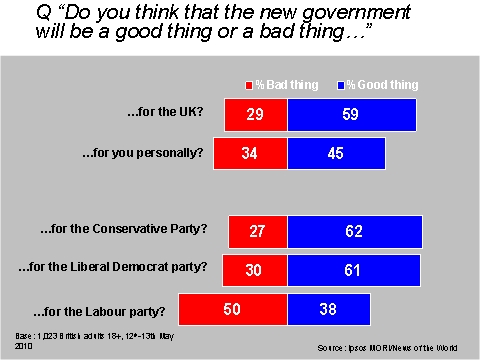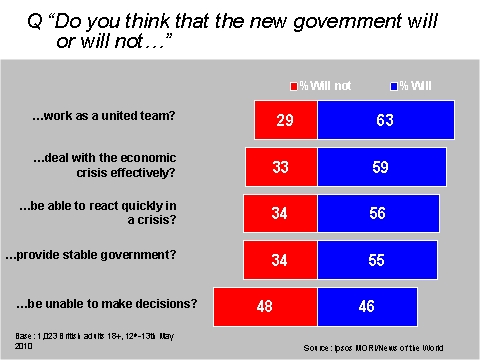 The electorate has embraced the coalition government, although it is still early days says Sir Robert Worcester. For the Conservatives, David Cameron, and the government as a whole a honeymoon effect is strongly in evidence. But voters still seem sceptical about Nick Clegg’s role in the post-election negotiations and the Liberal Democrats’ performance in the election.
The electorate has embraced the coalition government, although it is still early days says Sir Robert Worcester. For the Conservatives, David Cameron, and the government as a whole a honeymoon effect is strongly in evidence. But voters still seem sceptical about Nick Clegg’s role in the post-election negotiations and the Liberal Democrats’ performance in the election.
The coalition between the Conservatives and the Liberal Democrats had a good start, according to an Ipsos MORI survey for the News of the World (details in chart below). As the chart below shows, the new government was initially thought to be good for the UK by almost two to one, although fewer thought it was good for themselves (45 per cent) compared to a third (34 per cent) who disagreed. Equal numbers thought it was good for the Conservatives and for the Liberal Democrats as parties.

Three in four (72 per cent) believed that David Cameron was right to form a coalition with the Liberal Democrats. Nearly two thirds (64 per cent) also thought that Nick Clegg was right to take his party into the coalition with the Conservatives.
The public were also optimistic about the new government, as my second chart below shows. More than two to one thought that Conservative and Liberal Democrat ministers would work as a united team. Nearly six in ten believed the government that they would deal with the economic crisis effectively. A majority expected the coalition to be able to react quickly in a crisis and to provide a stable government, although a narrow margin of 48 per cent to 46 per cent also believed that the government will be unable to make decisions.

Now, at the end of the new Government’s first month, during which Cameron and Clegg have laid out a number of mechanisms for making decisions across a broad range of initiatives, I expect that an update on the poll would show that the new government has a substantial positive majority believing that it can make decisions.
The British public quickly accommodated to the idea of a coalition government after the election result, and has begun to reappraise their view of the new PM. After the first debate, 42 per cent of the electorate said they were dissatisfied with the way David Cameron was doing his job as leader of the Conservative Party. Immediately after polling day, dissatisfaction was cut in half, with only one person in five (21 per cent) saying they were dissatisfied.
Unfortunately for Nick Clegg, the impact on his standing is negative. The net dissatisfaction with his leadership increased from -15 per cent to -23 per cent, and the proportion of respondents who were “don’t knows” about him virtually doubled from 13 per cent to 24 per cent. So for him the jury is still out, perhaps reflecting the fact that the Liberal Democrats did not increase their votes at the general election and lost four seats.
Nor has Clegg gained much credit for the amazing negotiations which left him as Deputy Prime Minister, and five Liberal Democrats sitting in the Cabinet (not the three I expected). Still the Liberal Democrat leader has secured for himself control over the reform of parliament and the electoral system, and a very substantial say in the future of the coalition government. He will need to show sceptical voters that he can make effective use of this power.
This analysis was extracted from Sir Robert’s lecture to City University’s Forum for the Future Masters Students.







